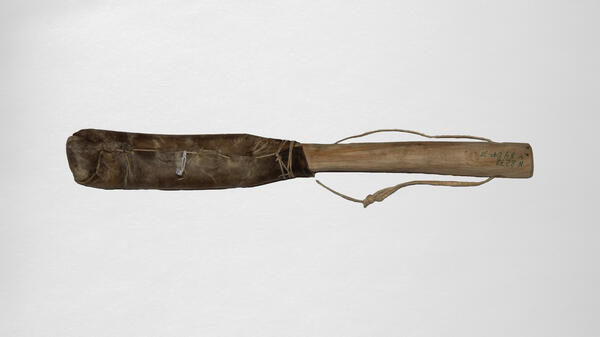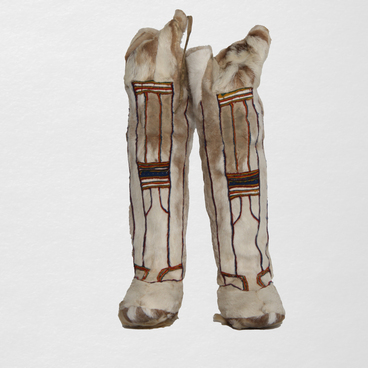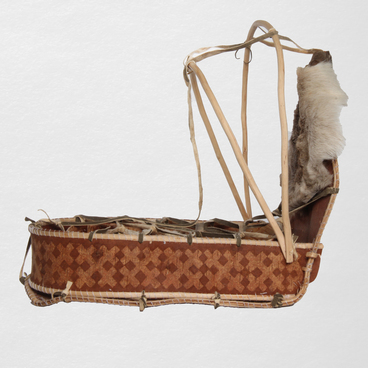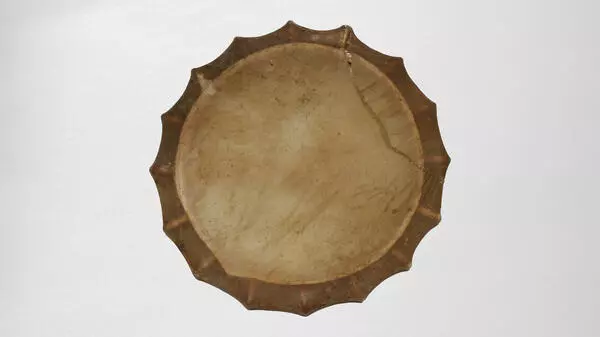Together with the Nenets shaman tambourine, the craftswoman Marina Nakova made a special mallet in 2007. Mallets, like tambourines, can be of different shapes and sizes, but most often it is a flat and slightly elongated wooden spade.
The Nenets used the word “khorey” to denote a long, round in cross-section and slightly curved pole, which was used for riding reindeer or guarding herds. A wide bone or wooden tip was placed at the thin end, which was used to steer deer, at the other end was an iron tip in the form of a short sword. It was used to drive away predators.
Shamans cured diseases, and helped when the intervention of supernatural forces was required. They communicated with the spirits, asked them to grant well-being, health and fertility to people and animals, as well as good luck in hunting and fishing. Shamans used to read fortune with an ax or a knife and thus could predict the future, find lost things, missing people and deer. They supervised the celebrations and sacrifices at holy sites.
The main attributes of the shaman were a tambourine and a mallet, and the main action was a shamanic ritual (“kamlaniye”). This was the name of the ritual of communication with the spirits, during which the shaman reached an ecstatic state. At these moments, various figures, bizarre stones, and animal skins served as his spiritual helpers.
Before the ritual, the shaman put on a special costume. During the ceremony, he depicted how, with the help of a tambourine, he flew to the heavenly god, descended into the lower world, fought against evil spirits. His improvisation was based on a good knowledge of the myths, tales and legends of his people, and the rituals included chants accompanied by strikes of a mallet on the tambourine. The shaman could practice shamanism anywhere: in the open air, on a river bank, in the house, but more often for this ritual a “black house” or “closed raw-hide tent” was assigned, where all the inhabitants of the surrounding villages gathered.
Both men and women could become shamans in the North. Usually the gift was inherited, but sometimes the spirits themselves chose a new shaman. A special illness reminiscent of temporary madness was considered to be the sign that the person had been chosen.
The shaman’s apprentice received his own tambourine only in the seventh year. The mentor showed what kind of wood an instrument could be made out of and how to make a mallet. With its help, a tambourine was tuned near a burning fire — it got a voice. The tambourine and the mallet were kept not in simple riding sledges, but in sacred ones. A few more years later, the new shaman was allowed to make pendants for his tambourine, and 10 years later he was considered an experienced shaman. In general, the training lasted 20 years.
The Nenets used the word “khorey” to denote a long, round in cross-section and slightly curved pole, which was used for riding reindeer or guarding herds. A wide bone or wooden tip was placed at the thin end, which was used to steer deer, at the other end was an iron tip in the form of a short sword. It was used to drive away predators.
Shamans cured diseases, and helped when the intervention of supernatural forces was required. They communicated with the spirits, asked them to grant well-being, health and fertility to people and animals, as well as good luck in hunting and fishing. Shamans used to read fortune with an ax or a knife and thus could predict the future, find lost things, missing people and deer. They supervised the celebrations and sacrifices at holy sites.
The main attributes of the shaman were a tambourine and a mallet, and the main action was a shamanic ritual (“kamlaniye”). This was the name of the ritual of communication with the spirits, during which the shaman reached an ecstatic state. At these moments, various figures, bizarre stones, and animal skins served as his spiritual helpers.
Before the ritual, the shaman put on a special costume. During the ceremony, he depicted how, with the help of a tambourine, he flew to the heavenly god, descended into the lower world, fought against evil spirits. His improvisation was based on a good knowledge of the myths, tales and legends of his people, and the rituals included chants accompanied by strikes of a mallet on the tambourine. The shaman could practice shamanism anywhere: in the open air, on a river bank, in the house, but more often for this ritual a “black house” or “closed raw-hide tent” was assigned, where all the inhabitants of the surrounding villages gathered.
Both men and women could become shamans in the North. Usually the gift was inherited, but sometimes the spirits themselves chose a new shaman. A special illness reminiscent of temporary madness was considered to be the sign that the person had been chosen.
The shaman’s apprentice received his own tambourine only in the seventh year. The mentor showed what kind of wood an instrument could be made out of and how to make a mallet. With its help, a tambourine was tuned near a burning fire — it got a voice. The tambourine and the mallet were kept not in simple riding sledges, but in sacred ones. A few more years later, the new shaman was allowed to make pendants for his tambourine, and 10 years later he was considered an experienced shaman. In general, the training lasted 20 years.




